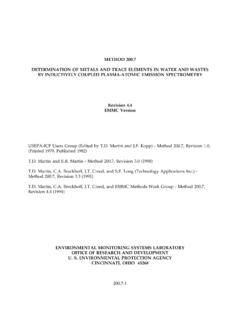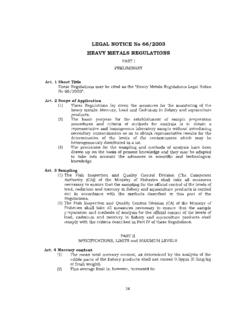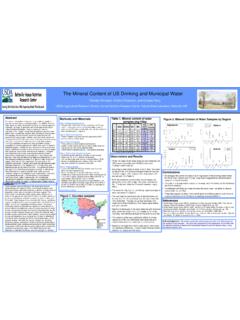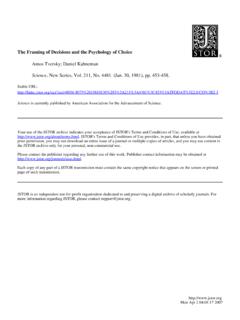Transcription of Guideline on the specification limits for residues of ...
1 European Medicines Agency Pre-authorisation Evaluation of Medicines for Human Use 7 Westferry Circus, Canary Wharf, London, E14 4HB, UK Tel. (44-20) 74 18 84 00 Fax (44-20) 74 18 86 13 E-mail: EMEA 2007 Reproduction and/or distribution of this document is authorised for non commercial purposes only provided the EMEA is acknowledged London, January 2007 Doc. Ref. CPMP/SWP/QWP/4446/00 corr. COMMITTEE FOR HUMAN MEDICINAL PRODUCTS (CHMP) Draft Guideline ON THE specification limits FOR residues OF metal CATALYSTS DRAFT AGREED BY THE SAFETY WORKING PARTY June 1998 -November 2000 ADOPTION BY CHMP FOR RELEASE FOR CONSULTATION January 2001 END OF CONSULTATION (DEADLINE FOR COMMENTS) July 2001 DISCUSSION IN THE SWP October 2001 June 2002 ADOPTION BY CHMP FOR RE- RELEASE FOR CONSULTATION June 2002 DISCUSSION IN THE SWP February 2003 December 2006 ADOPTION BY CHMP FOR RE- RELEASE FOR CONSULTATION January 2007 END OF CONSULTATION (DEADLINE FOR COMMENTS)
2 23rd May 2007 Comments should be provided using this template to +44 20 7418 8613 KEYWORDS metal catalysts, classification, concentration limits of metals, drug substance, excipients, PDE, administration routes, testing strategies, reporting levels No longer valid Guideline ON THE specification limits FOR residues OF metal CATALYSTS TABLE OF CONTENTS EXECUTIVE 1. INTRODUCTION (BACKGROUND).. 3 2. 4 3. LEGAL 4 4. MAIN Guideline 4 CLASSIFICATION OF 4 EXPOSURE 5 SETTING CONCENTRATION limits OF METALS: ORAL AND PARENTERAL 6 OTHER ADMINISTRATION 7 ACTIVE SUBSTANCES USED FOR SHORT-TERM 7 TESTING 7 ANALYTICAL 8 REPORTING LEVELS OF METALLIC 8 5.
3 8 REFERENCES (SCIENTIFIC AND / OR LEGAL).. 9 APPENDIX 1: RATIONALE FOR PDE 10 APPENDIX 2: MONOGRAPHS ON 11 PLATINUM (PT)..11 PALLADIUM (PD) .. 13 IRIDIUM (IR) .. 15 RHODIUM (RH) ..16 RUTHENIUM (RU) .. 16 OSMIUM (OS) .. 17 MOLYBDENUM (MO) .. 18 NICKEL (NI) .. 19 CHROMIUM (CR) .. 21 VANADIUM (V).. 23 COPPER (CU) .. 24 MANGANESE (MN) .. 26 ZINC (ZN) .. 27 IRON (FE) .. 29 APPENDIX 3: EXAMPLE CALCULATIONS FOR CONCENTRATION 30 EMEA 20077 Page 2/32 No longer validEXECUTIVE SUMMARY This Guideline recommends maximum acceptable limits of metal residues in drug substances and excipients. Residual metals used as process catalysts do not provide any therapeutic benefit and should therefore be evaluated and restricted on the foundation of safety- and quality-based criteria.
4 Metals will be classified in three categories based on their individual levels of safety concern and concentration limits will be set on the bases of the maximal daily dose, duration of treatment, route of administration and permitted daily exposure (PDE). Guidance is also given on testing strategies, analytical procedures and reporting levels in excipients and drug substances. 1. INTRODUCTION (background) The objective of this Guideline is to recommend, for the safety of the patient, maximum acceptable metal residues arising from the use of metals as catalysts or reagents in the synthesis of drug substances and excipients.
5 Since there is no therapeutic benefit from residual metals, specification acceptance criteria should be applied to those metals present in these pharmaceutical substances in a manner that is consistent with safety- and quality-based criteria. Since the use of catalysts or reagents is restricted to defined chemical reactions in the synthesis of pharmaceutical substances, limitation of residues in these substances is sufficient, and in general there is no need to set limits for metal residues in the final medicinal products containing these substances. This Guideline considers metal catalysts and reagents that are actually used in the synthesis of pharmaceutical substances; that is the drug substance(s) and excipient(s).
6 However, as the origin of the metal residues is irrelevant regarding their potential toxic effects, the safety data in this Guideline can also be used for specific metal residues in pharmaceutical products which are residues from other sources. The Guideline does not apply to metals that are deliberate components of the drug substance (such as a counter ion of a salt) or are an excipient in the drug product ( an iron oxide pigment). The metals included in this Guideline are listed in Table considerations with respect to the proposed permitted daily exposure (PDE) setting are discussed in Appendix 1. For each of the included metals individual monographs are included in Appendix 2.
7 In the reviews the following assumptions and/or default values are used: Body weight (bw) of an adult: 50 kg. Breathing volume of an adult: 20 m3 per day (24 h). Occupational (workplace) inhalation exposure: 8 h per day (24 h). Exposure limits were established using uncertainty factors as described in appendix 3 of the ICH Q3C guidance. For pragmatic reasons a number of uncertainty factors were adapted to arrive at a final safe and practical PDE setting - Q3C method for uncertainty factor (UF) calculation plus additional pragmatic factor for PDE calculation. Acceptable additional lifetime cancer risk: an increased cancer risk of 1 in 100,000 was identified as acceptable for genotoxic impurities in pharmaceuticals by the CHMP limits set based on safety criteria may therefore be higher than limits set on the basis of GMP, process capabilities, or other suitable quality criteria The Guideline may be updated to include other sources of metal residues and additional elements in due course.
8 Any interested party can make a request and submit relevant safety data. Classification and limits may change as new safety data becomes available. EMEA 20077 Page 3/32 No longer valid2. SCOPE metal catalysts and metal reagents are defined here as chemical substances that are used to change the rate of chemical reactions or which act on other chemical substances in chemical reactions. For the purposes of this Guideline , they are substances used in the synthesis of the drug substance or an excipient used in a medicinal product. residues of metals can either be present as the original form of the metal or as a form of the metallic element altered by downstream chemical processing.
9 Excluded from this document are extraneous metal contaminants that should not occur in drug substances or excipients and are more appropriately addressed as Good Manufacturing Practice (GMP) issues. This Guideline applies to new and existing marketed drug products. However for existing marketed drug products a time limit of 5 years is set for the implementation of the Guideline in cases an earlier implementation is not feasible. This Guideline does not apply to potential new drug substances, or excipients, used during the clinical research stages of development of a medicinal product. Different limits are applied to oral and parenteral routes of administration due to limited oral bioavailability of many metals.
10 As different routes of exposure may have different toxicological properties, specific limits have been set for inhalation exposure to some metals, see section When the exposure is short the PDE s mentioned in this Guideline may be adapted as indicated in section 3. LEGAL BASIS This Guideline has to be read in conjunction with Directive 2001/83/EC (as amended) and all relevant CHMP Guidance documents with special emphasis on: Note for Guidance on Impurities in New Drug Products (CPMP/ICH/2738/99, ICHQ3B (R)) Impurities Testing Guideline : Impurities in New Drug Substances (CPMP/ICH/2737/99, ICHQ3A) Note for Guidance on Impurities: Residual Solvents (CPMP/ICH/283/95 in conjunction with CPMP/ICH/1507/02) Guideline on the limits of Genotoxic Impurities (CPMP/SWP/5199/02) 4.














